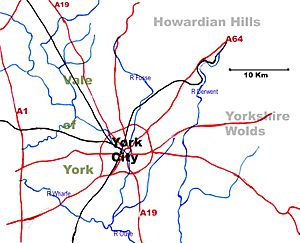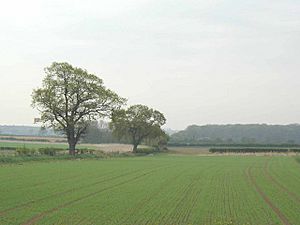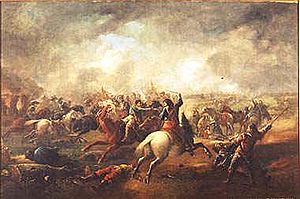Vale of York facts for kids
The Vale of York is a large, flat area of land in the northeast of England. It's a very important farming region and acts as a main route for travel from north to south in Northern England.
Many people think the Vale of York stretches from the River Tees in the north all the way to the Humber Estuary in the south. However, the true Vale of York is just the central part of this area. To its north is the Vale of Mowbray, and to its south are the Humberhead Levels. It is surrounded by the Howardian Hills and Yorkshire Wolds to the east, and the Pennines mountains to the west. A low ridge called the Escrick moraine marks its southern edge. The city of York is right in the middle of this area.
Contents
Geography
Climate
Like the rest of Great Britain, the Vale of York usually has cool summers and fairly mild winters. The weather changes often, not just between seasons but also day by day. Because of where it is on the map, the area often gets winds from the west. These winds bring weather systems that can make the weather unsettled and windy, especially in winter.
Sometimes, there are periods of good weather thanks to small, moving high-pressure systems. In winter, these can bring cold, dry days. In summer, they often lead to dry, settled conditions, which can sometimes cause droughts. The nearby Atlantic Ocean and the Gulf Stream make the winters milder and summers cooler than you might expect for this part of the world. Temperatures change daily, with nights usually being cooler, and January is the coldest month.
The Vale of York gets less rain than areas to its west because it's in the "rain shadow" of the Pennines. This means the mountains block some of the rain. It also gets more fog and frost in winter than other places. This happens because cold air tends to flow down into the valley from the higher ground around it.
Geology
Underneath the surface of the Vale of York are layers of rock like sandstone and mudstone, but you can't see them. The surface is covered by deposits left behind by ancient ice sheets. These include glacial till (a mix of clay, sand, and rocks), sand, and gravel. There are also ridges called moraines, which are piles of rock and dirt left by melting glaciers.
The Escrick moraine stretches across the vale from west to east. About 8 miles north of that, the York moraine forms another curved ridge, going from York towards Sand Hutton. North of these ridges, you'll find clay, sand, and gravel that were left by a large glacial lake. There are also areas of river alluvium, which is clay, silt, and sand deposited by the main rivers and streams.
Drainage
The Vale of York's water flows south through the River Ouse and its smaller rivers: the Ure, the Nidd, and the Foss. To the east, the River Derwent also flows south into the Ouse.
There are many smaller streams and drainage channels that connect to these main rivers across the vale. Local groups called internal drainage boards help manage these waterways. They make sure that water levels are kept at the right height throughout the vale.
Natural History
The land in the Vale of York is mostly flat and low. However, there are some small ridges and glacial moraines that add a bit of variety to the landscape. In areas with dry, sandy soils, you can still find small parts of old heathlands (open, uncultivated land) and ancient woodlands. There are also some large forests of conifer trees, mainly Scots Pine, growing in the less fertile sandy areas.
Most of the land is used for growing crops, so grasslands are not very common. There are very few flood meadows left along the river valleys. However, some important areas of these meadows still exist along the lower parts of the River Derwent.
History
Long before the Romans arrived, the drier parts of the Vale of York, away from the rivers, were already being used for farming animals and growing small amounts of crops. The Romans had a big impact on the area around York. They built their important fortress called Eboracum there. We can still find evidence of their villas (country houses), forts, signal stations, and roads they built.
The vale suffered greatly during the Harrying of the North. This was when King William I damaged the northern parts of England to punish people for fighting against his takeover. Later, in the Middle Ages, villages and manors (large estates) were set up with open fields. Some of these fields lasted until the 1700s, when new laws called the Enclosure Acts changed how land was owned. During the English Civil War, a famous battle called the Battle of Marston Moor was fought west of York between the King's supporters and Parliament's army.
Economy
The soils in the Vale of York, which come from glacial till, sand, and gravel, are generally very good for farming. Almost all the land is used for growing crops like wheat, sugar beet, and potatoes. There's been a steady change away from raising livestock and dairy farming in the area.
The city of York is the main economic hub of the vale. It's a popular place for tourists and has many shops and businesses. It's also a center for light engineering (making things like small machines) and food processing. The University of York and its science park are also very important for the local economy.
Transport
The A1 road and A19 road are major roads that run through the vale, carrying traffic north and south. Several other important roads branch out from York. The East Coast Main Line railway, which connects London to Edinburgh, also crosses the vale from north to south. There are also several train lines that go east and west, connecting to places like Leeds, Harrogate, and Scarborough.
Places of interest
Settlements
Apart from York, the largest town in the vale is Haxby. Other villages in the area often have a similar look. Their houses are typically made of pinkish brick with curved, tile roofs, and they face each other along a main street.
Images for kids







